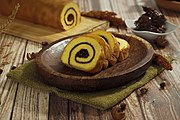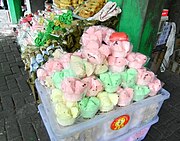
Kuih are bite-sized snack or dessert foods commonly found in Southeast Asia. It is a fairly broad term which may include items that would be called cakes, cookies, dumplings, pudding, biscuits, or pastries in English and are usually made from rice or glutinous rice. The term kuih is widely used in Malaysia, Brunei, and Singapore, and kueh or kue is used in Indonesia, to refer to sweet or savoury desserts. Though called by other names, one is likely to find various similar versions of kuih in neighbouring countries, such as Vietnam, Thailand, and Myanmar. For example, the colourful steamed kue lapis and the rich kuih bingka ubi are also available in Myanmar, Thailand, and Vietnam. In the Philippines, kuih are referred to in Tagalog as kakanin.

Murtabak is a stuffed pancake or pan-fried bread which is commonly found in the Arabian Peninsula and Southeast Asia, notably in Saudi Arabia, Kuwait, Yemen, Indonesia, Malaysia, Singapore, Brunei, and Thailand. Depending on the location, the name and ingredients can significantly vary. The name mutabbaq in Arabic means "folded". It is a popular street food in Indonesia, Malaysia, and Singapore.
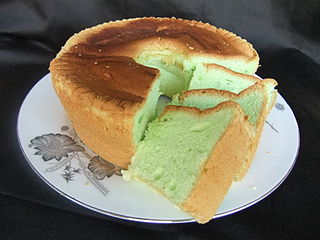
Pandan cake is a light, fluffy, green-coloured sponge cake flavoured with the juices of Pandanus amaryllifolius leaves. It is also known as pandan chiffon. The cake is popular in Indonesia, Malaysia, Singapore, Vietnam, Cambodia, Laos, Thailand, Sri Lanka, Hong Kong, China, and also the Netherlands, especially among the Indo community, due to its historical colonial ties with Indonesia. It is similar to the buko pandan cake of the Philippines, but differs in that it does not use coconut.

Kue is an Indonesian bite-sized snack or dessert food. Kue is a fairly broad term in Indonesian to describe a wide variety of snacks; cakes, cookies, fritters, pies, scones, and patisserie. Kue are made from a variety of ingredients in various forms, some are steamed, fried or baked. Kue are popular snacks in Indonesia, which has the largest variety of kue. Because of the countries' historical colonial ties, Koeé (kue) is also popular in the Netherlands.

Pandanus amaryllifolius is a tropical plant in the Pandanus (screwpine) genus, which is commonly known as pandan. It has fragrant leaves which are used widely for flavouring in the cuisines of Southeast Asia and South Asia.
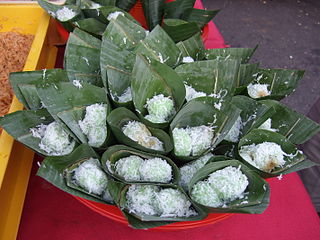
Klepon, or kelepon, is a snack of sweet rice cake balls filled with molten palm sugar and coated in grated coconut. Of Javanese origin, the green-coloured glutinous rice balls are one of the popular traditional kue in Indonesian cuisine. It is also commonly found in neighbouring countries such as Malaysia, Brunei and Singapore as onde-onde.

Serabi, also called surabi, srabi, also known in Thailand as khanom khrok, is an Indonesian pancake that is made from rice flour with coconut milk or shredded coconut as an emulsifier. Most of traditional serabi tastes sweet, as the pancake is usually eaten with kinca or thick golden-brownish-colored coconut sugar syrup. However, another savoury version also existed that uses oncom toppings. Different provinces in various Asian countries have their own serabi recipes corresponding to local tastes.

Serundeng refers to a side dish or condiment to accompany rice in Indonesian and Malay languages. Serundeng may taste sweet, or hot and spicy according to recipe variants.
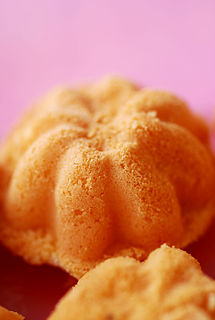
Bahulu or baulu is a traditional Malay pastry (kue/kuih). It is similar in concept to the madeleine cake, but round in shape and composed of different ingredients. There are three versions available, the most common being bahulu cermai (star-shaped) and the more elusive bahulu gulung and bahulu lapis (layered). Bahulu is believed to be originated in Malay Peninsula during the colonization era and is the corruption of the Malaccan Kristang word, bolu which means cake. It is usually served during Eid al-Fitr as well as during the Chinese New Year.
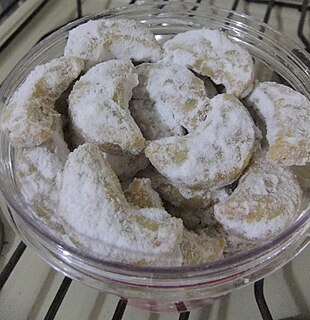
Putri salju is an Indonesian kue kering shaped like crescents and covered with powdered sugar. Putri salju is Indonesian for "snow princess", referring to the powdered sugar coating that resembles snow.

Kue lapis is an Indonesian kue, or a traditional snack of steamed colourful layered soft rice flour pudding. In Indonesian lapis means "layers". This steamed layered sticky rice cake or pudding is quite popular in Indonesia, Suriname and can also be found in the Netherlands through their colonial links. Kue lapis is also very popular in neighbouring Malaysia, Singapore, and Brunei where it is called kuih lapis. Kue lapis was introduced by the Sino-Burmese to Lower Myanmar, where it is known as kway lapay (ကွေလာပေး) or kway lapaysa (ကွေလာပေးစ).

Kue mangkok or kue mangkuk is an Indonesian kue or traditional snack of steamed cupcake. Kue mangkok means "bowl/cup cake". It is similar to the snack bolu kukus. While both have a similar appearance, bolu kukus requires few ingredients to make, whereas kue kangkok requires more than a dozen in most recipes. The result is a different texure: bolu kukus is soft and fluffy, while kue mangkok has a rough texture.

Bolu kukus is an Indonesian traditional snack of steamed sponge cupcake. The term "bolu kukus" however, usually refer to a type of kue mangkuk that mainly only uses wheat flour with sugar, eggs, milk, soda, and also using common vanilla, chocolate, pandan or strawberry flavouring, acquired from food flavouring essence. The cake uses beaten eggs and soda as emulsifier, the type of soda being lemon sparkling water, usually Sprite.

Palembangese cuisine is the cuisine of the Palembangese people of the city of Palembang in the South Sumatra province of Indonesia. It is the second most well-known cuisine from Sumatra after Padang.

Kue talam is an Indonesian kue or traditional steamed snack made of a rice flour, coconut milk and other ingredients in a mold pan called talam which means "tray" in Indonesian. The cake mold used to create kue talam are either larger rectangular aluminium tray or smaller singular cups made from ceramics, aluminium, melamine or plastic.

Kue bangkit is a small biscuit that made from sago starch of Malay origin, commonly found in Indonesia and Malaysia. This biscuit has various colours, ranging from white, yellowish to brown, depends on the additional ingredients.

Kamir, also known as khamir or samir is a round-shaped bread that almost similar to apem or pancake, consists of flour, butter, and egg mixture, sometimes mixed with other fillings ingredients such as banana, tapai, strawberry, pineapple, jackfruit, cheese, and chocolate.

Indo cuisine is a fusion cooking and cuisine tradition, mainly existing in Indonesia and the Netherlands, as well as Belgium, South Africa and Suriname. This cuisine characterized of fusion cuisine that consists of original Indonesian cuisine with Eurasian-influences—mainly Dutch, also Portuguese, Spanish and British—and vice versa. Nowaday, not only Indo people who consume Indo cuisine, but also Indonesians and Dutch people.
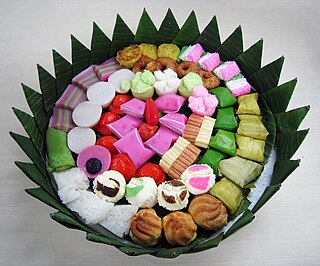
Jajan pasar refers to traditional Javanese cakes sold in the Javanese markets.



